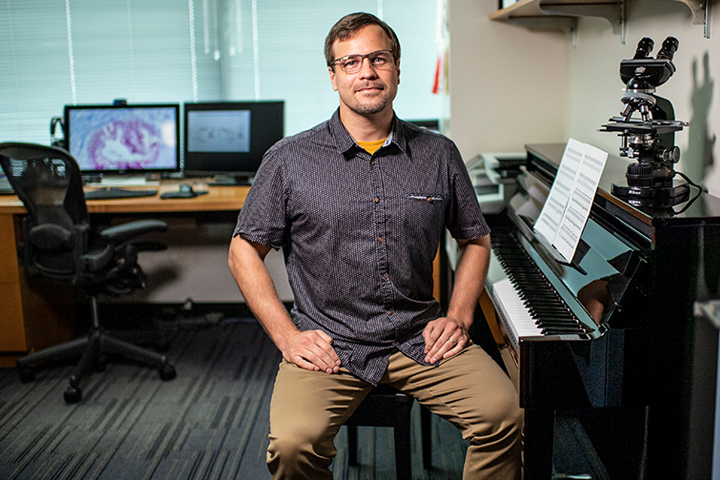Clinical Trial For OncoTreat Being Developed

Medical research falls into one of three buckets: basic, clinical, and translational.
Basic research is all about the nuts and bolts, demystifying at a fundamental level what makes a lethal disease like pancreatic cancer tick. Clinical research is all about patients, and finding out through rigorously controlled trials whether certain new drugs or other approaches are actually better than what’s currently the standard of care. Then there’s translational research. It bridges the gap between the basic sciences and clinical research.
“We would all like there to be better therapies for pancreas cancer, because there is such great need,” says pancreatic cancer researcher Kenneth Olive, Ph.D., associate professor in the department of medicine and director of the Oncology Precision Therapeutics and Imaging Core Shared Resource at Columbia University’s Herbert Irving Comprehensive Cancer Center (New York). “I’m a translational researcher and what we do in translational research is to take what’s learned through the basic sciences and then come up with ideas for how different chemicals, basically different drugs, can be used to treat people.”
But before these drugs can be tested in patients they must be tested in preclinical settings such as the so-called “Mouse Hospital,” a pivotal research approach in the Olive Laboratory at Columbia. It’s here where genetically engineered mouse models bred to develop pancreatic cancer are treated in the same way that human patients would be treated. That means the mice undergo everything from sophisticated imaging to being part of randomized controlled preclinical trials. “What we want to do is to see and to understand at a very deep level the mechanisms of why the drugs may or may not be working, and then get the right drugs into the patient population,” Olive says. “What we want to do is to find better treatments, and hopefully find a cure for pancreas cancer.”
DNA Is the Blueprint; RNA Is the Work Order
It’s a lofty goal, which is going to take the combined efforts of not only numerous disciplines, but also of some very creative thinkers. This is one reason why Olive is admittedly excited to be working alongside Columbia’s Andrea Califano, Ph.D. Califano, along with a multidisciplinary team, developed a novel computational framework called OncoTreat. Its focus is personalized cancer treatment. Simply, the program matches individual tumors with a drug or drug combination that can destroy those tumors. “His (Califano’s) approach is as different as anything I’ve seen,” Olive says. “And, yes, it’s fair to say I’m pretty excited.”
The researchers received a $2.2 million grant from the Lustgarten Foundation to support a clinical trial of the OncoTreat framework as well as associated preclinical studies for the treatment of metastatic pancreatic cancer. The clinical trial, currently under development by Olive and his clinical colleague Dr. Rachael Safyan, is dubbed HIPPOCRATES, which stands for High-throughput Pancreas Precision Oncology by Cell Regulatory-network Analysis based Therapy Selection.
Matching individual tumors with the drug or drug combinations that are most likely to destroy those tumors is the gist of precision or personalized medicine. But instead of targeting mutations found in DNA, a hallmark of conventional precision medicine approaches, the researchers will be analyzing RNA.
Going back to some basic biology, RNA is simply a copy, or a transcription, of DNA. DNA never leaves the nucleus of a cell, while RNA goes out to do work throughout that cell. In the trial, samples of each patient’s tumor are transplanted into mice as a surrogate model in which to test the top predicted therapies that are readily available. The top validated agent will then be used to determine the optimal treatment for each patient in the second line setting, with the goals of assessing safety and feasibility and identifying early indications of efficacy of the RNA-based precision medicine approach, according to the Lustgarten Foundation. “What we’re doing is looking at the actual state of the cancer cell and how we can target the context of that cell.” Olive says. “The end result is that he’s (Califano) found a way to mathematically encode and interpret the details of RNA expression.”
The easiest way to look at all of this is that DNA is the blueprint of a cell and RNA is the work order. “It’s the RNA that’s going to most accurately reflect what’s currently going on inside a tumor, and what genetic programs are keeping all of those malignant cells alive and thriving,” he adds.
A major hurdle in making precision medicine more accessible and beneficial to pancreatic cancer patients is that the disease has few genetic drivers. Unfortunately, one of the most prevalent, KRAS, is tough to target. “Going after DNA mutations can make sense, and there’s no question about that, but pancreas cancer isn’t like chronic myelogenous leukemia where you have a drug like imatinib (Gleevec) targeted against the dominant genetic driver of the disease, which absolutely transformed lives,” Olive explains. “In pancreas cancer you have maybe about 15 percent of patients who have anactionable mutation that can be targeted. We need to be able to help the other 85 percent.”
Extraordinarily Hopeful
Olive is quick to point out the work is still in early stages, and he’s cautious about making promises. “It is my nature to be extraordinarily hopeful, and that stems from what I’m seeing in the labs and in the literature,” he notes. “I’ve been steeped in pancreas cancer research since 2005. There weren’t that many of us back then. All the researchers knew each other, and there was a real sense of collegiality.
“Now pancreas cancer research has taken off. There are so many more scientists studying the disease, but there’s still that incredible sense of collegiality and a real focused goal of finding answers. It’s going to happen. I don’t have any doubts about that. The way that we are looking at the problem is one possible way that can potentially transform lives.”




